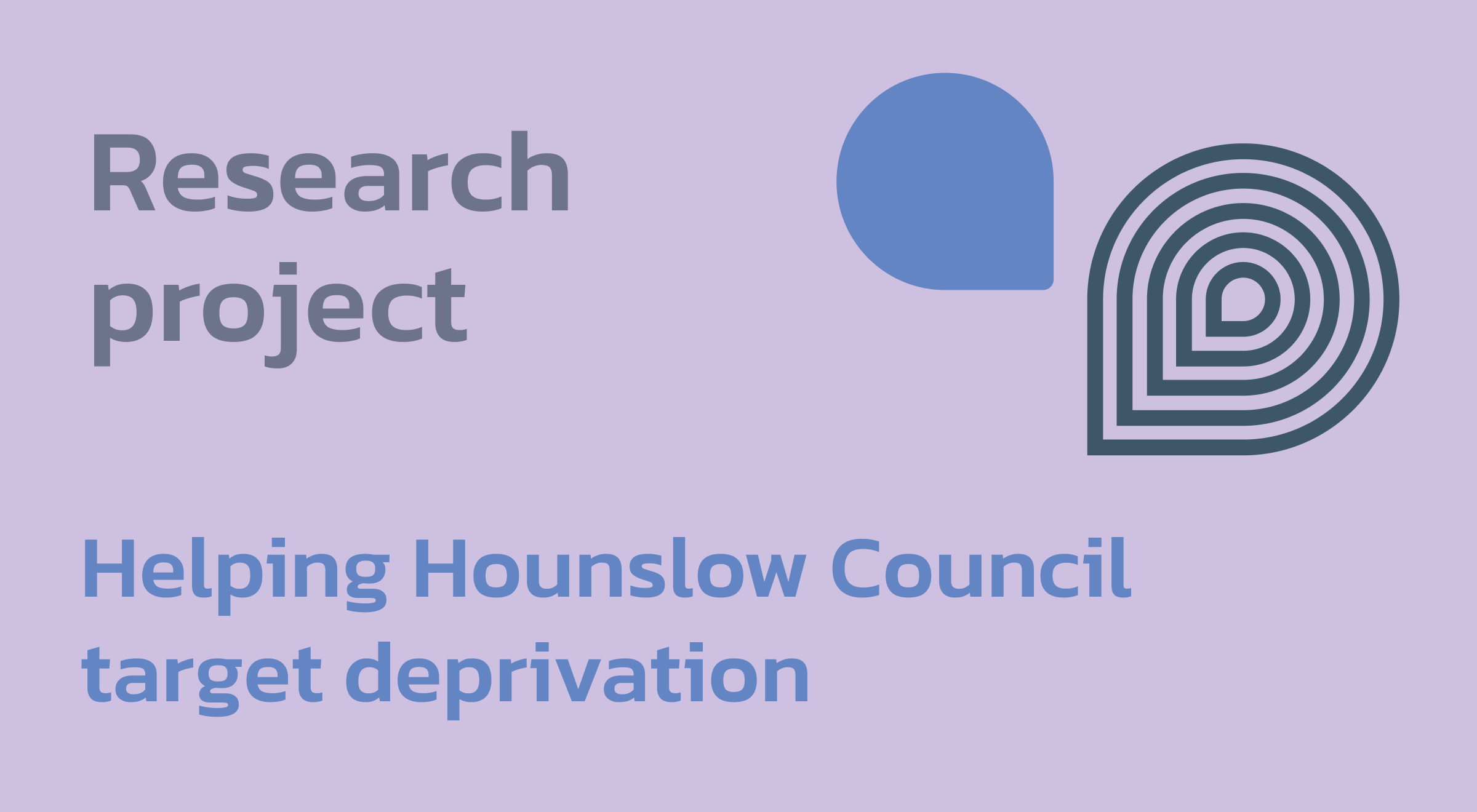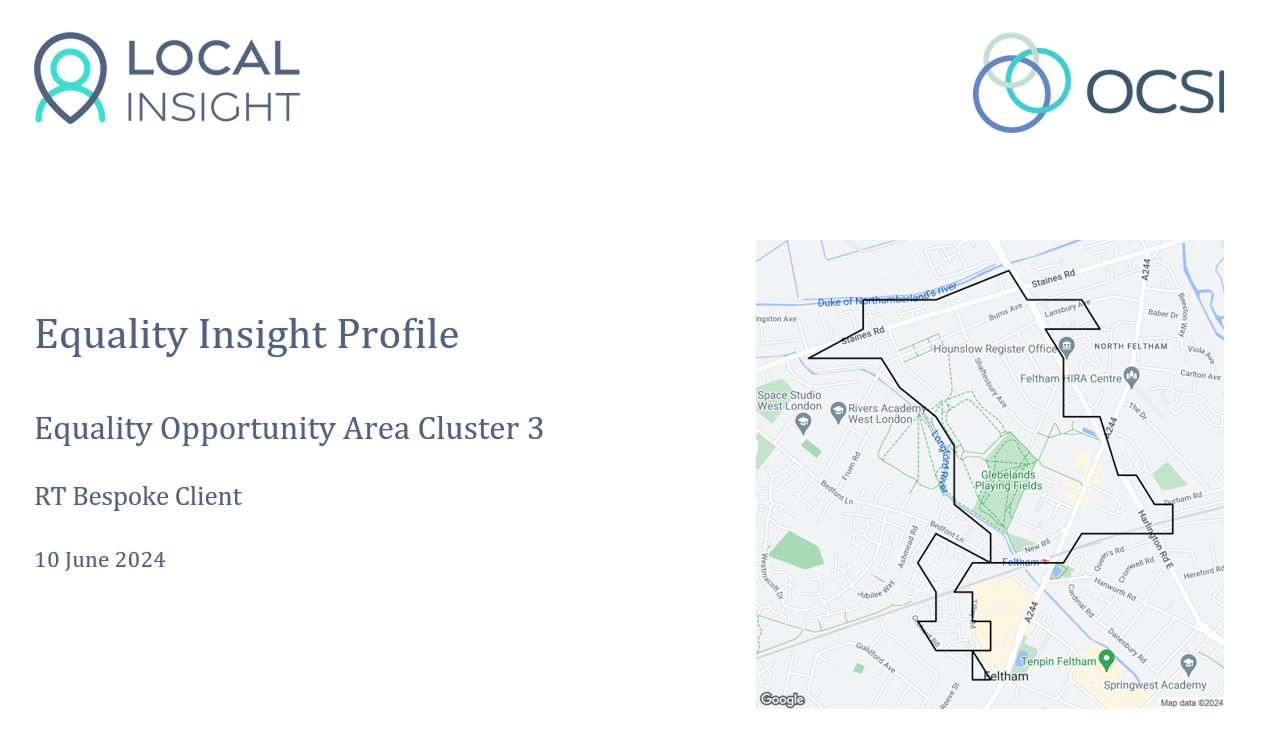
This case study will focus on OCSI’s ongoing collaboration with Hounslow Council, where we’ve worked together to turn complex data into accessible, actionable insights. Over the years, we’ve supported the council in identifying priority neighbourhoods, making the case for targeted investment and embedding a data-led approach in the heart of their strategy.
Since 2021, we’ve been working with Hounslow Council to bring strong evidence into their decision-making. These projects include the identification of priority neighbourhoods for intervention, and ensuring target investment in the areas that need it most.
To understand the impact of our collaboration, we spoke to Celia Golden, Head of Equality and Inclusion at Hounslow Council, to learn more about the outcomes of these projects.
Hounslow Council set out with a clear goal: to create a ‘Fairer, More Equal Hounslow’, addressing inequalities between neighbourhoods, redirecting investment to deprived areas and revitalising town centres to benefit residents.
The council needed to know exactly where to focus their efforts, and target the communities that were most in need – and they needed clear evidence to back up those decisions. Data on deprivation and community need existed, but it was scattered and complex. For a small council team of two, combing through raw statistics to pinpoint problem areas was time-consuming and challenging.
Before working with OCSI, Celia explained that: “We struggled to pinpoint exactly where our interventions should be targeted. Now, we have a clear, evidence-based rationale for where investment is needed most.”
They needed a way to turn that scattered and complex data into simple, actionable insights that anyone – from councillors to community partners – could understand and support.
This became especially urgent during the COVID-19 pandemic, when the council needed to quickly identify and support vulnerable residents using location-based data. It underscored that a data-driven approach was crucial not just in a crisis, but also in tackling long-term inequality. Hounslow’s team needed support to gather the right data, and present it in a simple and compelling way to drive action in their community.
Hounslow Council partnered with OCSI to provide the accessible data tools and analysis they needed to support their decision-making. Over several years, we worked closely with Celia’s team to transform complex datasets into user-friendly and insightful resources.

Our next project with Hounslow saw us analyse a wide range of data, from local statistics and census records to the Indices of Deprivation, with the aim of identifying which parts of the borough were most disadvantaged. This analysis highlighted ten neighbourhood clusters that clearly needed targeted attention.
To visualise these priority areas, we created an easy-to-understand map and dashboard which allow councillors and officials to quickly see where deprivation was concentrated.
As Celia put it, “OCSI’s work enabled us to identify specific geographical areas that need targeted intervention, giving us a clearer framework for decision-making.”
Since then, Hounslow Council have used this data to create their own needs analysis and data visualisations which continue to support these neighbourhood clusters.

To consider not only demographic makeup, but also service provision, we looked at community infrastructure such as the availability of civic assets (community centres, libraries, parks) and the quality of transport links in each neighbourhood. We also examined social factors for each of Hounslow’s wards. This meant finding the areas with fewer community facilities, poor access to public transport, or those with multiple socio-economic challenges – such as increased unemployment rates and high housing or childcare needs.
These reports made it clear what issues were affecting each part of the borough, and with this information, the council could more effectively work with partners to address specific problems. For example, Hounslow Council used the data to discuss improvements for poorly-connected areas with Transport for London. We examined how different demographic groups were faring, to ensure that no group was overlooked when planning interventions. These insights were delivered in simple summaries and charts, making it easy for the council to incorporate the evidence into their strategies and funding bids.

“The Social Infrastructure Report has given us a data-led approach to improving local services, ensuring investment reaches areas with the greatest need.” – Celia Golden
For Hounslow, these data-driven insights quickly translated into real-world changes and benefits, both inside the council and in the wider community.
With a clear picture of need, the council could confidently direct funding and programmes to the right places. They launched initiatives in at-risk neighbourhoods flagged by our research – for example, holding job fairs on estates with the highest unemployment – instead of relying on one-size-fits-all borough-wide programs.
Other services like health outreach and housing improvements were similarly steered toward priority areas. With the evidence to back up these decisions, they became easier to make and to justify, both internally and to the public. The evidence also strengthened Hounslow’s bids for external funding, since they could demonstrate exactly which areas would benefit and why.
The success of this approach led to changes in how the council operates, with the use of data now standard in its processes. Reports and policy proposals must demonstrate the support that priority areas will receive. Celia described the policy as: “One of the most significant steps we’ve taken towards embedding data-led fairness in our operations.”
In practice, this means considering community equity isn’t just a tick-box exercise – it’s a required part of planning. Using the data as a framework, Hounslow has made sure that helping its most deprived communities remains at the heart of every decision, and has used this approach to justify funding bids in recent cabinet reports.
The insights didn’t just stay within the council, but were used to rally others around the same goals. Hounslow shared the findings with local partners like the NHS and schools, enabling them to align their efforts with the evidence.
The council also held workshops and “funder fairs” with dozens of charities and community organisations. Celia’s team presented local needs data and encouraged these groups to target their projects – and tailor their grant bids – towards the neighbourhoods most in need.
By equipping the third sector with data, the council allowed partners to take more coordinated, evidence-backed action across the borough. They also invited residents from the priority areas to engagement sessions, where they would compare the data with lived experience. This ensured what locals felt on the ground aligned with the numbers that were now informing decisions.
Planning and community intervention within Hounslow is now both data-driven and community-informed, making policy changes more effective, and strengthening public trust.
If you’re looking to explore how you can integrate neighbourhood-level data into your strategic planning, we can help.
Our research can support local government in better understanding community need, and helps to direct investment to where it matters most.
Find out more about our Research Services, and get in touch to find out more about how we can support your work.
A new need for deeper place-based insight When Arts Council England launched…
More
The 2025 Index of Multiple Deprivation (IMD) provides an updated view of…
More
The English Indices of Deprivation 2025 (IoD 2025) have now been published…
More